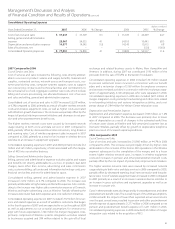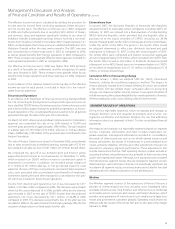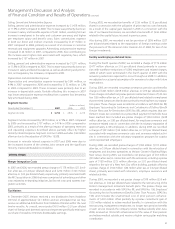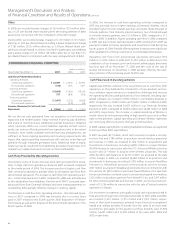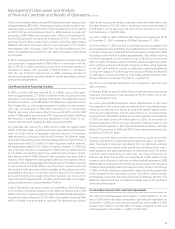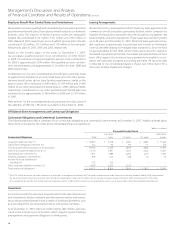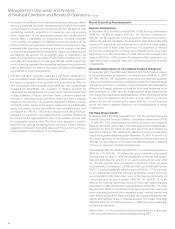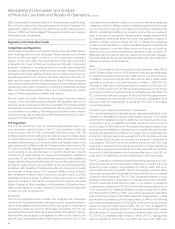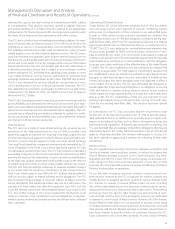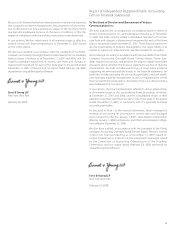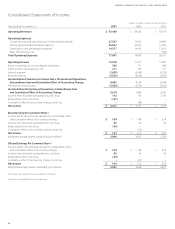Verizon Wireless 2007 Annual Report Download - page 33
Download and view the complete annual report
Please find page 33 of the 2007 Verizon Wireless annual report below. You can navigate through the pages in the report by either clicking on the pages listed below, or by using the keyword search tool below to find specific information within the annual report.
related to these hedge contracts, which along with the unrealized for-
eign currency translation balance on the investment hedged, remain in
Accumulated Other Comprehensive Loss until the investment is sold. We
have not hedged our accounting translation exposure to foreign currency
fluctuations relative to the carrying value of our other investments.
CRITICAL ACCOUNTING ESTIMATES AND
RECENT ACCOUNTING PRONOUNCEMENTS
Critical Accounting Estimates
A summary of the critical accounting estimates used in preparing our
financial statements are as follows:
• Verizon’s plant, property and equipment balance represents a sig-
nificant component of our consolidated assets. Depreciation expense
on Verizon’s local telephone operations is principally based on the
composite group remaining life method and straight-line composite
rates, which provides for the recognition of the cost of the remaining
net investment in telephone plant, less anticipated net salvage value,
over the remaining asset lives. We depreciate other plant, property
and equipment generally on a straight-line basis over the estimated
useful life of the assets. Changes in the remaining useful lives of assets
as a result of technological change or other changes in circumstances,
including competitive factors in the markets where we operate, can
have a significant impact on asset balances and depreciation expense.
• We maintain benefit plans for most of our employees, including pen-
sion and other postretirement benefit plans. In the aggregate, the
fair value of pension plan assets exceeds benefit obligations, which
contributes to pension plan income. Other postretirement benefit
plans have larger benefit obligations than plan assets, resulting in
expense. Significant benefit plan assumptions, including the discount
rate used, the long-term rate of return on plan assets and health care
trend rates are periodically updated and impact the amount of ben-
efit plan income, expense, assets and obligations (see “Consolidated
Results of Operations – Consolidated Operating Expenses – Pension
andOtherPostretirementBenefits”).Asensitivityanalysisoftheimpact
of changes in these assumptions on the benefit obligations and
expense (income) recorded as of December 31, 2007 and for the year
then ended pertaining to Verizon’s pension and postretirement benefit
plans is provided in the table below.
(dollars in millions)
Percentage
point
change
Benet obligation
increase
(decrease) at
December 31, 2007
Expense increase
(decrease) for the
year ended
December 31, 2007
Pension plans
discount rate + 0.50 $ (1,768) $ (64)
- 0.50 1,886 109
Long-term rate of return
on pension plan assets + 1.00 – (374)
- 1.00 – 374
Postretirement plans
discount rate + 0.50 (1,442) (117)
- 0.50 1,579 118
Long-term rate of return
on postretirement
plan assets + 1.00 – (37)
- 1.00 – 37
Health care trend rates + 1.00 3,038 489
- 1.00 (2,512) (378)
MARKET RISK
We are exposed to various types of market risk in the normal course
of business, including the impact of interest rate changes, foreign cur-
rency exchange rate fluctuations, changes in equity investment and
commodity prices and changes in corporate tax rates. We employ risk
management strategies using a variety of derivatives, including interest
rate swap agreements, interest rate locks, foreign currency forwards and
commodity swaps. We do not hold derivatives for trading purposes.
It is our general policy to enter into interest rate, foreign currency and
other derivative transactions only to the extent necessary to achieve our
desired objectives in limiting our exposure to the various market risks.
Our objectives include maintaining a mix of fixed and variable rate debt
to lower borrowing costs within reasonable risk parameters and to pro-
tect against earnings and cash flow volatility resulting from changes
in market conditions. We do not hedge our market risk exposure in a
manner that would completely eliminate the effect of changes in interest
rates, commodity prices and foreign exchange rates on our earnings. We
do not expect that our net income, liquidity and cash flows will be mate-
rially affected by these risk management strategies.
Interest Rate Risk
The table that follows summarizes the fair values of our long-term debt
and interest rate derivatives as of December 31, 2007 and 2006. The table
also provides a sensitivity analysis of the estimated fair values of these
financial instruments assuming 100-basis-point upward and downward
shifts in the yield curve. Our sensitivity analysis does not include the fair
values of our commercial paper and bank loans, if any, because they are
not significantly affected by changes in market interest rates.
(dollars in millions)
At December 31, 2007 Fair Value
Fair Value
assuming
+100 basis
point shift
Fair Value
assuming
–100 basis
point shift
Long-term debt and interest
rate derivatives $ 31,930 $ 30,154 $ 33,957
At December 31, 2006
Long-term debt and interest
rate derivatives $ 33,569 $ 31,724 $ 35,607
Foreign Currency Translation
The functional currency for our foreign operations is primarily the
local currency. The translation of income statement and balance sheet
amounts of our foreign operations into U.S. dollars are recorded as cumu-
lative translation adjustments, which are included in Accumulated Other
Comprehensive Loss in our consolidated balance sheets. The transla-
tion gains and losses of foreign currency transactions and balances are
recorded in the consolidated statements of income in Other Income and
(Expense), Net and Income from Discontinued Operations, Net of Tax. At
December 31, 2007, our primary translation exposure was to the British
Pound and the Euro.
During 2007, we entered into foreign currency forward contracts to hedge
a portion of our net investment in Vodafone Omnitel. Changes in fair value
of these contracts due to Euro exchange rate fluctuations are recognized
in Accumulated Other Comprehensive Loss and partially offset the impact
of foreign currency changes on the value of our net investment. As of
December 31, 2007, Accumulated Other Comprehensive Loss includes
unrecognized losses of approximately $57 million ($37 million after-tax)
31
Management’s Discussion and Analysis
ofFinancialConditionandResultsofOperations continued


